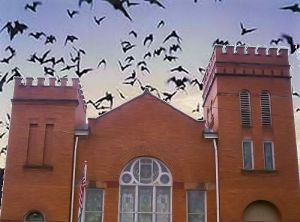The phrase BATS IN THE BELFRY means crazy or eccentric.
The phrase has the sound of a phrase from Olde Englande and it certainly has the imagery to fit into any number of Gothic novels based in English parsonages or turreted castles. In fact, it comes from the USA and is not especially old. This article from the Ohio newspaper The Newark Daily Advocate, October 1900 includes it:
Discover, Share and help us Preserve our lost and forgotten stories.
Become an Alabama Pioneers Patron
“To his hundreds of friends and acquaintances in Newark, these purile [sic] and senseless attacks on Hon. John W. Cassingham are akin to the vaporings of the fellow with a large flock of bats in his belfry.”
Do you need some guidance in your genealogy search? Save time and avoid pitfalls in your research. This book provides simple, no-nonsense instructions to help you get started. Many FREE research links are included. Where Do I Start is filled with Hints and Tips to begin your family genealogy research and acquire Genealogy information.
- WHERE TO FIND – online resources, experienced genealogists will not be aware of many of these.
- COURT RESEARCH – how to do courthouse research, where to find birth, death, social security records free online.
- EIGHTY – ONE QUESTIONS – you should ask your elderly loved ones before it’s too late.
- TIPS ON BREAKING DOWN THE WALL – Everyone faces some difficulties in research, often called a ‘brick wall’ but WHERE DO I START? provides suggestions for overcoming them.
READER REVIEW
“Donna shares how she “got bitten” by the genealogy bug. She imparts her amazement at how much can be learned about the history of this country as well as one’s own family by researching one’s family tree. And what’s more amazing is that she was able to go back with her family to the 1600s in England, over 400 years.The author has a website where she is asked many “how to” questions by the participants. She advises one to use a computer for their research and seems to describe the use of genealogy software as an easy task and quite intuitive. She identifies many excellent genealogy websites for the new user, some of which I hadn’t known about despite my history of 20 years of searching for my family tree, much of it on the internet. The author provides sample interview questions for eliciting past stories from family elders. She gives quite a few tips on how to organize your materials to make the best use of your time. She includes everything a “newby” to the genealogy research field will need to get started and more. And for those with more experience, she includes tips on how to break down the “brick walls” that researchers inevitably encounter and she advises readers to challenge the assumptions in family lore and stories when the brick wall is hit. She also identifies many of the pitfalls inherent in requested records. And if you’ve ever gone to a courthouse to search without preparing yourself for the kinds of questions you’ll need to ask, you will appreciate the author’s advice about getting ready first. You’ll save yourself time in the long run.


